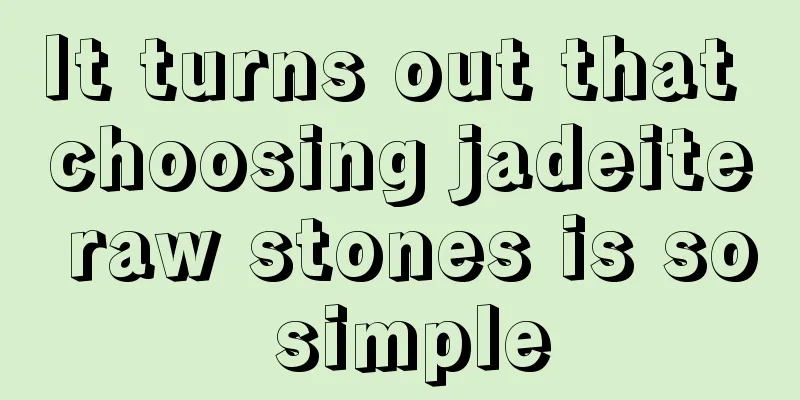Popular Science Post - Several Methods for Identifying Natural Jade

|
Friends often hold up a piece of jade and ask me if it is jadeite. In order to solve this problem, the editor in this issue will teach you some simple and easy-to-understand natural jade identification techniques, hoping it will be helpful to everyone. Fiber interwoven structureThe jadeite particles that make up jade are intertwined in a fibrous manner, similar to the fibers of tissue paper entangled with each other. Jade with a fiber interwoven structure is relatively rare, so we can preliminarily determine whether the jade is jadeite based on the structure. Green jadeite particles interwoven in a silky pattern The structure is clearer under transmitted light MicroripplesJade is composed of more than one mineral, jadeite. The hardness of other minerals is lower than that of jadeite. In addition, jadeite has hardness anisotropy, which causes jade to form uneven, wavy patterns after polishing - micro-ripples. The micro-ripples under the reflected light are like ripples on the lake surface The artificially processed B-grade jade (bleached and filled jade) and B+C jade (bleached, filled and dyed jade) on the market have lower colloid hardness. After polishing, part of the colloid filling between the particles will be carried away, leaving behind a series of criss-crossing grooves, which are called acid etching reticulation. EmeraldJadeite has two sets of cleavages, so jade sometimes shows flashes on the cleavage surfaces, which is what we often call jadeite texture. Depending on the size of the reflective surface, it can be divided into snowflakes, fly wings, and sand stars. Color RootOn jade jewelry, the gradual transition of green in linear, vein-like, and flake-like forms to the relatively lighter range around them is called color roots. The color roots have a certain color influence and will make the surrounding areas appear green. The color roots of natural jade have a dense and deep feeling, and the color distribution is mostly uneven. The color of dyed jade is distributed in a spider-web-like pattern with a strong floating feeling. The color of some dyed jade is too bright and uniform, which can also be used as a basis for identification. Green is rooted in natural jade When natural jade is not polished, it appears green overall, and the color of the color root diffuses significantly. Under the transmitted light of natural jadeite, the color roots take off the green coat that covers them and reveal their true appearance. Dyed jadeite, the colors float and are distributed in a spider web shape Secondary yellow tintDuring the formation process of jade, it is inevitable that some iron oxides will invade between the particles, forming the secondary yellow hue unique to natural jade. When observed through light, the base of natural jade has a light yellow tint Artificially processed jade has undergone acid washing, and the secondary substances between the mineral particles will be removed, causing the overall base to appear pale white, without the yellow hue of natural jade. In addition, natural jade can also be identified through methods such as weighing, knocking, feeling the coolness, and instrument testing. These are just basic introductory tutorials. The rich contents of jadeite culture, deposit types, causes, optimization treatment methods, variety evaluation, market overview, and differentiation of similar jades will be explained in detail in our jadeite identification and trade courses. fcgc66 fcpf18 |
>>: Have you used these 5 common methods of identifying jadeite? It's all fake...
Recommend
Let your jade pendant become more versatile!
The peace locket is a common and popular jade pat...
The small jadeite rough stone found at the night market for 2,000 yuan was carved into a unique exquisite piece
Next, I would like to share with you the followin...
Half-Faced Beauty | Half mountain, half water, love and hate intertwined
All women in the world love bracelets. But there ...
How to choose colorless jade?
1. Choose the water head As the saying goes, &quo...
Don’t just think of green when you mention jade, there are seven other real good ones!
When mentioning jade, the first thing that comes ...
Not all jade is suitable for setting. You will definitely regret it if you set the third type!
With the deepening of cultural exchanges between ...
“Heavy makeup” jade, discovering different beauty
The beauty of jade is unquestionable and multifac...
It's obvious that the certificate is fake! The easiest way to identify jadeite
Every time when we talk about buying jadeite, we ...
Which is better, plain jade or carved jade?
Are jade carvings better with carved patterns or ...
Jadeite collection has great investment prospects
Since ancient times, jade has been regarded as th...
Buy jade? Experts suggest you at least be aware of these jargons!
Every industry has its own jargon, and every sent...
The Jade Variety That Gives Goosebumps to People When They Hear It - Black Chicken Jade
Speaking of jade, the first thing that comes to m...
Take a quick look at your jade pendant and see if you have chosen the right one!
Jade pendants are jade ornaments made of jade as ...
The favorite of jade carvers - Damakan jadeite raw stone, the first choice for skillful carving!
I believe that all of you jade lovers are familia...
There are ten jargons you must know about jadeite. Are you sure you understand them all?
Every industry has its own jargon, and every sent...









